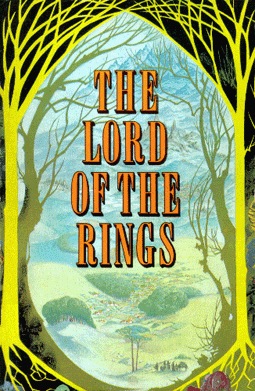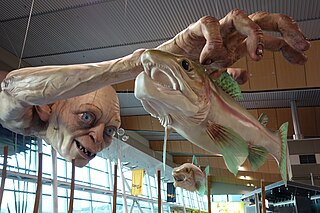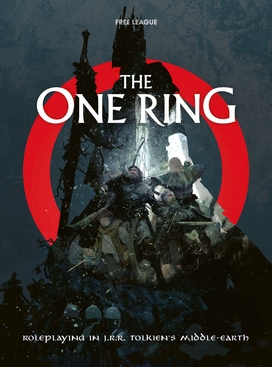Related Research Articles

The Lord of the Rings is an epic high fantasy novel by the English author and scholar J. R. R. Tolkien. Set in Middle-earth, the story began as a sequel to Tolkien's 1937 children's book The Hobbit, but eventually developed into a much larger work. Written in stages between 1937 and 1949, The Lord of the Rings is one of the best-selling books ever written, with over 150 million copies sold.

Bilbo Baggins is the title character and protagonist of J. R. R. Tolkien's 1937 novel The Hobbit, a supporting character in The Lord of the Rings, and the fictional narrator of many of Tolkien's Middle-earth writings. The Hobbit is selected by the wizard Gandalf to help Thorin and his party of Dwarves reclaim their ancestral home and treasure, which has been seized by the dragon Smaug. Bilbo sets out in The Hobbit timid and comfort-loving and, through his adventures, grows to become a useful and resourceful member of the quest.
Shelob is a fictional monster in the form of a giant spider from J. R. R. Tolkien's The Lord of the Rings. Her lair lies in Cirith Ungol leading into Mordor. The creature Gollum deliberately leads the Hobbit protagonist Frodo there in hopes of recovering the One Ring by letting Shelob attack Frodo. The plan is foiled when Samwise Gamgee temporarily blinds Shelob with the Phial of Galadriel, and then severely wounds her with Frodo's Elvish sword, Sting.

Tom Bombadil is a character in J. R. R. Tolkien's legendarium. He first appeared in print in a 1934 poem called "The Adventures of Tom Bombadil", which also included The Lord of the Rings characters Goldberry, Old Man Willow and the barrow-wight, from whom he rescues the hobbits. They were not then explicitly part of the older legends that became The Silmarillion, and are not mentioned in The Hobbit.
Bree is a fictional village in J. R. R. Tolkien's Middle-earth, east of the Shire. Bree-land, which contains Bree and a few other villages, is the only place where Hobbits and Men lived side by side. It was inspired by the name of the Buckinghamshire village of Brill, meaning "hill-hill", which Tolkien visited regularly in his early years at the University of Oxford, and informed by his passion for linguistics.

"The Man in the Moon Stayed Up Too Late" is J. R. R. Tolkien's imagined original song behind the nursery rhyme "Hey Diddle Diddle ", invented by back-formation. It was first published in Yorkshire Poetry magazine in 1923, and was reused in extended form in the 1954–55 The Lord of the Rings as a song sung by Frodo Baggins in the Prancing Pony inn. The extended version was republished in the 1962 collection The Adventures of Tom Bombadil.

The Lord of the Rings: The Fellowship of the Ring is a 2002 action-adventure video game developed by WXP for the Xbox. Two additional versions were developed by Pocket Studios for Game Boy Advance and by Surreal Software for PlayStation 2 and Windows. The game was published by Vivendi Universal Games under their Black Label Games publishing label. In North America, it was released for Xbox and Game Boy Advance in September, and for PlayStation 2 and Windows in October. In Europe, it was released for Xbox, Windows and Game Boy Advance in November, and for PlayStation 2 in December.

Lord of the Rings is a cooperative board game based on the high fantasy novel The Lord of the Rings by J. R. R. Tolkien. Published in 2000 by Kosmos in Germany, Wizards of the Coast in the U.S., and Parker Brothers in the U.K., the game is designed by Reiner Knizia and features artwork by illustrator John Howe. In the game, each player plays a hobbit in the party, and the party will aim to destroy the One Ring. Upon its release, the game received a Spiel des Jahres special award. A slightly revised version was later published by Fantasy Flight Games.

"The Road Goes Ever On" is a title that encompasses several walking songs that J. R. R. Tolkien wrote for his Middle-earth legendarium. Within the stories, the original song was composed by Bilbo Baggins and recorded in The Hobbit. Different versions of it also appear in The Lord of the Rings, along with some similar walking songs.

War of the Ring is a strategy board game based on The Lord of the Rings by J.R.R. Tolkien. The game was made by Roberto Di Meglio, Marco Maggi and Francesco Nepitello, first produced by Nexus Editrice (Italy), and is currently published by Ares Games.

Gollum is a monster with a distinctive style of speech in J. R. R. Tolkien's fantasy world of Middle-earth. He was introduced in the 1937 fantasy novel The Hobbit, and became important in its sequel, The Lord of the Rings. Gollum was a Stoor Hobbit of the River-folk who lived near the Gladden Fields. In The Lord of the Rings, it is stated that he was originally known as Sméagol, corrupted by the One Ring, and later named Gollum after his habit of making "a horrible swallowing noise in his throat".
John D. Rateliff is an American independent scholar of fantasy literature and author of roleplaying games. He specializes in the study of the works of J. R. R. Tolkien, particularly his Middle-earth writings, and wrote and edited the 2007 book The History of the Hobbit.
Frodo Baggins is a fictional character in J. R. R. Tolkien's writings and one of the protagonists in The Lord of the Rings. Frodo is a hobbit of the Shire who inherits the One Ring from his cousin Bilbo Baggins, described familiarly as "uncle", and undertakes the quest to destroy it in the fires of Mount Doom in Mordor. He is mentioned in Tolkien's posthumously published works, The Silmarillion and Unfinished Tales.

Hobitit is a nine-part Finnish live action fantasy television miniseries directed by Timo Torikka, originally broadcast in 1993 on Yle TV1.

The One Ring Roleplaying Game is a tabletop role-playing game set in J. R. R. Tolkien's Middle-earth, set at the time between The Hobbit and The Lord of the Rings. Designed by Francesco Nepitello and Marco Maggi, the game was initially published by Cubicle 7 in 2011 under the title The One Ring: Adventures over the Edge of the Wild. Cubicle 7 continued to publish the first edition of the game until 2019. Nepitello and Maggi developed the second edition, which is published by Free League Publishing under the same title, The One Ring Roleplaying Game.

The Lord of the Rings: The Card Game is a card game produced by Fantasy Flight Games since 2011. As part of the Living Card Game (LCG) genre, it is a cooperative and strategic card game set in Middle-earth, a fantasy world featured in literary works by J. R. R. Tolkien, including The Hobbit and The Lord of the Rings.
"The Shadow of the Past" is the second chapter of J. R. R. Tolkien's bestselling fantasy work, The Lord of the Rings, which was published in 1954–1955. Tolkien called it "the crucial chapter"; the Tolkien scholar Tom Shippey labelled it "the vital chapter". This is because it represents both the moment that Tolkien devised the central plot of the book, and the point in the story where the protagonist, Frodo Baggins, and the reader realise that there will be a quest to destroy the Ring. A sketch of it was among the first parts of the book to be written, early in 1938; later that year, it was one of three chapters of the book that he drafted. In 1944, he returned to the chapter, adding descriptions of Gollum, the Ring, and the hunt for Gollum.
Riddle of the Ring is a board game published by Fellowship Games in 1977 based on J.R.R. Tolkien's The Lord of the Rings; it was republished by Iron Crown Enterprises (ICE) in 1982.
Lego The Lord of the Rings is a Lego theme based on The Lord of the Rings film trilogy directed by Peter Jackson and the novel by the English author and scholar J. R. R. Tolkien. It is licensed from Warner Bros., New Line Cinema and Metro-Goldwyn-Mayer. The theme was first introduced in 2012. The first sets appeared in 2012, to coincide with a release of the video game Lego The Lord of the Rings. Subsequent sets based on The Hobbit film trilogy would also be released and the video game Lego The Hobbit was released in 2014. The product line was discontinued by the end of 2015. Later, the theme was relaunched in January 2023 with three new sets released as the part of the Lego BrickHeadz theme. In February 2023, The Lego Group unveiled a new Rivendell set that released on 8 March 2023 as the part of the Lego Icons theme. Further, a Barad-Dûr set released on 1 June 2024, also as part of the Icons theme.
J. R. R. Tolkien used frame stories throughout his Middle-earth writings, especially his legendarium, to make the works resemble a genuine mythology written and edited by many hands over a long period of time. He described in detail how his fictional characters wrote their books and transmitted them to others, and showed how later in-universe editors annotated the material.
References
- ↑ "'Hobbit Tales--a One Ring Card Game'". ICv2 . 2013-07-18. Archived from the original on 2024-03-09. Retrieved 2024-03-09.
- ↑ "Grab A Pint And Sit Down For Hobbit Tales". 14 October 2013.
- ↑ "Telling Tall Tales: A Review of 'Hobbit Tales from the Green Dragon Inn' - The Gaming Gang". 14 August 2014.
- ↑ Appelcline, Shannon (2014). Adamus, John (ed.). Designers & Dragons: The '00s. Silver Spring, Maryland: Evil Hat Productions. p. 357. ISBN 978-1-61317-087-8.
- ↑ "I Racconti Di Frodo Diventano Un Gioco: Si chiama "Hobbit Tales" ed è un boardgame narrativo ambientato nel mondo del "Signore degli Anelli" creato dal genio di Tolkien" [Frodo's Tales Become A Game: It's called "Hobbit Tales" and it's a narrative boardgame set in the world of the "Lord of the Rings" created by the genius of Tolkien]. Unicusano Focus. Corriere dello Sport (in Italian). 2017-03-28. p. 4. Retrieved 2024-03-09– via Issuu.
- 1 2 Bacelli, Bruno (2014-09-03). "Arriva Hobbit Tales: Gioco di narrazione ambientato nel mondo della Terra di Mezzo di Tolkien, si svolge interamente per mezzo di carte" [Hobbit Tales arrives: Storytelling game set in Tolkien's world of Middle Earth, it takes place entirely through cards.]. FantasyMagazine (in Italian). Archived from the original on 2024-03-09. Retrieved 2024-03-09.
- ↑ "Event Report: Gencon 46". Diary of the Doctor Who Role-Playing Games. No. 21. 2014-01-21. p. 311. Retrieved 2024-03-09– via Internet Archive.
- ↑ Bacelli, Bruno (2014-09-11). "Una prova su strada per Hobbit Tales: Gioco di carte e di narrazione, Hobbit Tales, distribuito da Giochi Uniti, può dare molti spunti divertenti senza prendervi troppo tempo. È anche un ausilio di gioco compatibile con il Gioco di Ruolo L'Unico Anello" [A road test for Hobbit Tales: Card and storytelling game, Hobbit Tales, distributed by Giochi Uniti, can give you many fun ideas without taking up too much of your time. It is also a game aid compatible with the One Ring Role Playing Game.]. FantasyMagazine (in Italian). Archived from the original on 2024-03-09. Retrieved 2024-03-09.
- ↑ Arnaudo, Marco (2018). Storytelling in the Modern Board Game: Narrative Trends from the Late 1960s to Today. Jefferson, North Carolina: McFarland & Company. pp. 191–192. ISBN 978-1-4766-6951-9 . Retrieved 2024-03-09– via Google Books.
- ↑ "Announcing the 2014 ENnie Award winners". 16 August 2014. Archived from the original on 9 April 2019. Retrieved 23 September 2014.
- ↑ https://imgur.com/a/Dl6Bdxv
- ↑ "Histoires de Hobbits | Article | RPGGeek".